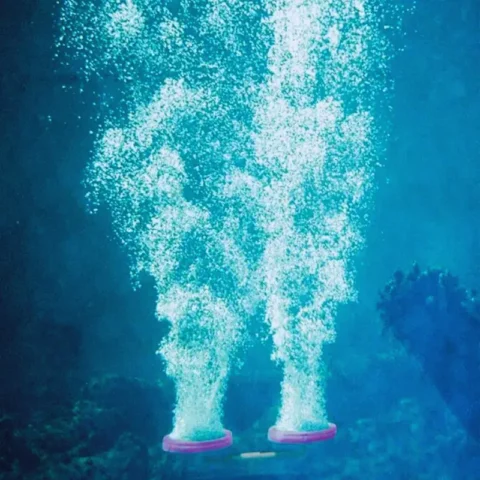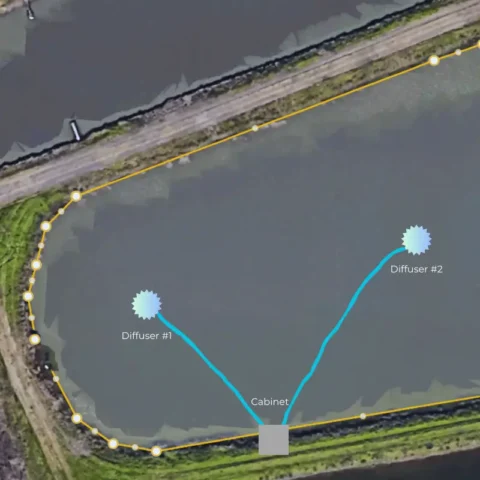Lake and Pond Aeration

Lake and pond aeration basics
Learn about pond aeration systems components, concepts, features and benefits. Having a clear understanding of these concepts will help you understand the importance of having proper aeration for your lake or pond.
Explore this topic
Surface vs. Sub-Surface Aeration
Learn the differences between surface and subsurface aeration and how to determine which is the best for your lake or pond.
explore this topic
aeration system sizing
Learn the role that size, shape and depth of your pond plays in the proper sizing of your aeration system.
Explore this topic
Frequently asked questions
Here are some frequently asked questions regarding lake and pond aeration, a complex topic that is often surrounded by misinformation. We have provided accurate answers to many common questions, ensuring that you can rely on the information presented. If you cannot find the answer to your specific question, please do not hesitate to contact us. Our team is always happy to provide personalized assistance and address any concerns you may have.
Contact usWhy is the placement of diffusers in my pond so important?
It is recommended to position the diffuser in the deepest part of the lake to maximize the diffusion of oxygen into the water. The distance that the bubbles travel in the water is directly proportional to the amount of oxygen that is diffused. Therefore, placing the diffuser deeper in the water will result in a greater diffusion of oxygen. Additionally, it is important to eliminate thermoclines and ensure that the oxygen is evenly distributed throughout the entire water column of the lake, particularly at the bottom where organic waste tends to accumulate. This will help to effectively distribute the oxygen and improve the overall health of the lake.
I don’t have electricity at my pond, can I still have an aeration system for my pond?
Yes, you can!
To set up the system, identify a suitable location near your home with access to an electrical source for your cabinet or compressor. Subsequently, dig a trench from this location to the edge of your pond and install a 1″ Sch 40 PVC pipe within the trench. This conduit serves as the oxygen delivery mechanism from your compressor to the pond’s edge. Fortunately, the distance of the trench does not affect pressure or air flow, making it a convenient and tidy solution.
In addition, the cost of running air to the pond is approximately 30% lower than running electricity to the same location.
I have a windmill aerator. Is that adequate aeration for my pond?
No, windmill aerators are not adequate.
It must be understood that ponds don’t store oxygen, and various factors can lead to oxygen depletion. These factors include:
- Calm weather: Lack of wind can reduce aeration during both day and night.
- Natural events: Sudden or gradual biological oxygen demand (BOD) increases can occur due to various factors. If your windmill isn’t generating oxygen due to calm conditions, this can lead to disaster.
So, it’s not a matter of “if” but “when” oxygen depletion occurs if you are depending on a windmill or other wind powered aeration system.
I depend on run off and my pond gets significantly lower in dry weather conditions. Should I aerate my pond?
Absolutely – it is especially important in this situation!
During a pond’s water level drop, overcrowding occurs among fish, aquatic life, and vegetation, reducing available oxygen. Shallow water also warms up, leading to decreased oxygen. Extended drought can cause oxygen demand to exceed supply, resulting in fish mortality due to oxygen depletion.
I have a fountain in my pond, will I need additional aeration?
In general, additional aeration is necessary for proper pond aeration.
Although fountains may enhance the aesthetics of a pond, they are NOT effective aeration devices.
Fountains consume a lot of energy and result in significant water loss due to evaporation, making them an inefficient and expensive source of aeration. Moreover, fountains are typically turned off during the most critical times when the pond requires the most oxygen, from 12 midnight to 6 AM.
Therefore, fountains should NOT be considered a solution for properly aerating a lake or pond, despite their aesthetic appeal.
I am running well water into my pond. Will that aerate my pond?
NO, well water is totally devoid of oxygen. If you must run well water into your pond, take every step you can to break up the water into a spray, and add well water only during the daylight hours.
I made my own aeration system. Will that provide adequate aeration in my pond?
The majority of homemade aeration systems, more than 80%, fail to meet the requirements for proper pond aeration due to their deviation from the fundamental principles of sub-surface aeration.
The essential components of a sub-surface aeration system include: a compressor that pumps high volumes of air at low pressure and energy costs, specialized weighted tubing that transports oxygen from the compressor to the bottom diffuser, and a bottom diffuser that effectively diffuses air into millions of tiny bubbles without coalescing.
This increases the transfer of dissolved oxygen into the water column by orders of magnitude due to the greater surface area of millions of tiny bubbles compared to fewer large bubbles, which is common in cheap or homemade solutions. Our experience with thousands of homemade aeration systems supports this observation.
We highly recommend reading our article on Lake and Pond Aeration Basics for more detailed information.
How do I best determine if I need to aerate my pond?
Proper pond aeration is crucial for maintaining the well-being and productivity of a lake or pond by ensuring the distribution of large amounts of dissolved oxygen throughout the water.
To determine if a sub-surface aeration system is necessary for your pond, consider the following questions:
- Do you want to support thriving fish populations and fishing opportunities, while avoiding sudden fish deaths and setbacks?
- Do you want to consistently maintain high-quality, healthy water for fish, animals, and other users of the water?
- Do you want to manage vegetation issues effectively and prevent unwanted vegetation growth in the long term?
- Do you want to make sound investments in your pond to ensure it remains a valuable asset, rather than a liability with ongoing problems?
If you answered “yes” to at least two of these questions, a sub-surface aeration system is necessary to obtain the results you seek for your pond.
We highly recommend reading our article on Lake and Pond Aeration Basics for more detailed information.


